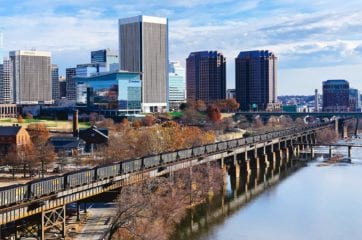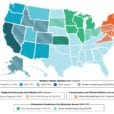This webinar is part of the State Carbon Pricing Network’s Deep Dive webinar series Each month, we explore a carbon pricing topic in depth, bringing in experts and pushing forward the conversation.
Transportation is currently expensive, inefficient and highly polluting. Passenger cars clog the roads and make it impossible to travel quickly, diesel buses emit harmful pollutants in urban areas, and transportation infrastructure is not well maintained or updated. Each year, drivers in the Greater Boston Area waste an average of 60 hours in congestion and traffic. Those same drivers individually waste an average $160 per month in lost productivity, higher fuel costs, and higher costs of goods. Nationally, transportation makes up just under 16% of average annual spending — after housing, the sector makes up the largest category of spending for the average American.
The next decade will require solutions to transform the sector, both for the sake of our climate and our daily livelihoods. The Transportation Climate Initiative (TCI) is one of the most promising new programs that aims to address transportation emissions and help people make the lifestyle changes necessary to meet transit, climate and equity goals.
So what exactly is TCI? What does the program mean for climate and transportation policy in the region? What role can the pivotal relationship between transportation and climate play in the coming decade to substantially reduce emissions by 2030 and improve the region’s inefficient infrastructure?
Transportation experts Chris Dempsey of Transportation for Massachusetts (T4MA), Lindsey Mendelson of the Sierra Club, and Jordan Stutt of Acadia Center joined Jonah Kurman-Faber of Climate XChange and the State Carbon Pricing Network to dive into the policy design and implications of the regional cap-and-trade program known as the Transportation and Climate Initiative (TCI).
What is the Transportation and Climate Initiative?
The Transportation and Climate Initiative (TCI) is a regional cap-and-invest program for transportation emissions across 12 Northeast and Mid-Atlantic states. Connecticut, Delaware, Maryland, Massachusetts, New Jersey, Pennsylvania, Rhode Island, Vermont, Virginia, and Washington, DC have formally agreed to move forward with a policy to reduce transportation emissions; Maine, New York, and New Hampshire are participating but have not formally signed on yet.
In 2017 and 2018, these states engaged with stakeholders to determine policy solutions to reduce greenhouse gas emissions from transportation. According to Mendelson, the most frequently offered suggestion from stakeholders was a program that prices carbon and uses the proceeds to invest in clean transportation options and modernizes our transportation system. Then, in December 2018, nine states and Washington, DC announced they would be designing a program to cap and reduce carbon emissions and invest the proceeds in low-carbon forms of transportation.
On October 1st, TCI states released a framework for a draft regional policy proposal, which provides an overview and outline of what this program is going to look like. A draft Memorandum of Understanding (MOU) will be released in December of this year, providing more details about what the final policy will look like. After additional feedback from stakeholders, a final MOU will be released in spring 2020 and states will begin to implement the program individually.
The cap will be implemented from 2022 to 2032, but the trajectory of the cap has not been determined. TCI is currently in modeling phase, and can learn from existing programs like RGGI and WCI. Advocates are pushing for the cap to be a 40-45% reduction from 1990 levels. The biggest question: Will the cap ensure that we can achieve the necessary greenhouse gas reductions from the transportation sector to achieve our goals?
The presenters talked about the benefits of a regional approach to tackle transportation emissions. Emissions don’t stop at state borders, so regulations to reduce them shouldn’t either. According to Mendelson, the Sierra Club ran a poll last June across the region, and nearly 3 in 4 voters across the Northeast and Mid-Atlantic (74%) support a regional approach to modernizing our transportation sector and reducing pollution by investing in electric vehicles, public transportation and safer communities for walking and biking. There is also strong bi-partisan support for modernizing the sector.
Why are we talking about Transportation?
Although cars have gotten more efficient over the past few decades, and auto emission standards have gotten stricter, gasoline sales are at an all-time high. Vehicle miles traveled have increased, and transportation emissions have risen over the past decade. As of 2017, transportation has become the leading source of greenhouse gas pollution across all US sectors. Over 75% of Americans get to work by driving alone, and light-duty passenger vehicles make up 60% of transportation emissions.
The alternative to driving? Opting to use inefficient, expensive, and often unreliable public transportation. According to Dempsey, it takes the 111 MBTA bus — the third-busiest bus in the MBTA system — 45 minutes to travel 2.7 miles across the Tobin Bridge to get from Chelsea to Boston. It’s faster to walk over the bridge than ride the bus, but that’s not an option.
Moreover, since 1991, Massachusetts has increased the gas tax by 14% — only 3 cents in almost 3 decades — but MBTA bus fares increased 300% and MBTA subway fares increased by 220%. “Every economic signal that we’re sending people is ‘drive more and take transit less’ — the opposite of what’s going to help achieve our goals,” Dempsey said.
Equitable solutions for an inequitable problem
Dempsey highlighted the public health impacts of the transportation sector; they are “hitting people in ways that we wouldn’t always think of or expect […] and it’s especially true of Americans that are living in TCI states which tend to be denser and have more highways than more open states.” More than 10% of Americans live within 1,500 feet of a highway, meaning they have a greater likelihood of developing cardiovascular disease and other emission-related diseases than those living twice as far away. The impacts of this public health crisis are not hitting all residents equally. In a study looking at the impacts of transportation pollution by race, the Union of Concerned Scientists found that Latinx, Asian Americans, and African Americans are being hit hardest by pollution.
The TCI framework highlights equity as a key element of this program. Exactly what this means is still being determined, but it has been a focus at stakeholder events to get input from communities that have been affected the most by transportation pollution and have lacked access to good transportation options. It’s going to be up to individual states on how they spend TCI revenue, so they can better address local community needs. Communities continue to share their input on how this can be done, and all three experts encourage people to continue. Stutt said TCI will be more successful if states incorporate stakeholder input on what those needs are, and how to give people access to efficient, low-carbon travel options. As Kurman-Faber’s latest report explores, California serves as an example of how carbon pricing funds can be used in a just transition. The state has invested billions of dollars in programs that are designed to address local needs in disadvantaged or low-income communities, like the Transformative Climate Communities program.
What this means for state-level policy
According to Stutt, “TCI doesn’t necessarily need to be the driving force of these emission reductions, but it needs to be a backstop and a tool that helps us achieve those emission reductions faster and more cost-effectively than we would do without this program.”
TCI will play a key role in transforming the region’s transportation, but “we need to be using every tool in our toolbox,” according to Dempsey. This includes advancing better policies around electric vehicle incentives and rebates, establishing congestion pricing to reduce pollution and congestion in urban areas, and expanding active transportation options like biking or walking infrastructure.
Thinking more broadly, carbon pricing bills can specifically be designed to be complementary to TCI and RGGI as well, like Massachusetts Representative Jen Benson’s bill. In a state like Massachusetts, the two cap-and-invest programs would only cover 60% of the state’s carbon dioxide emissions; a carbon price in the building and heating sectors would ensure the entire economy is covered.
Looking ahead
“We know that our transportation system is not working,” Mendelson said about the need to improve transportation infrastructure. TCI is expected to raise billions of dollars annually — something many TCI states desperately need. Maryland alone needs $18 billion in investments to meet their climate goals.
In addition to meeting climate goals, TCI will benefit residents living in these states. Georgetown Climate Center found that investing $3 billion annually would create 100,000 new jobs in the region and save families a total of $13.4 billion in 2030.
“It’s going to be a very busy two years in the TCI world,” Stutt said, “particularly in the next six months.” TCI program implementation will start as early as 2022, but there’s work that still needs to be done. The biggest thing you can do? Get engaged in the conversation and “hold your state leaders accountable” for the promises states make to vulnerable or under-served communities.
TCI will generate funds that states will help create a “cleaner, more equitable, more accessible transportation future.” As Stutt points out, “we can’t afford to wait” anymore.









